Reading time for children: 10 min
Once upon a time there was a widow who had two daughters. One of them was beautiful and industrious, the other ugly and lazy. The mother, however, loved the ugly and lazy one best, because she was her own daughter, and so the other, who was only her step-daughter, was made to do all the work of the house, and was quite the Cinderella of the family.
Her step-mother sent her out every day to sit by the well in the high-road, there to spin until she made her fingers bleed. Now it chanced one day that some blood fell on to the spindle, and as the girl stooped over the well to wash it off, the spindle suddenly sprang out of her hand and fell into the water. She ran home crying to tell of her misfortune, but her stepmother spoke harshly to her, and after giving her a violent scolding, said unkindly, „As you have let the spindle fall into the well you may go yourself and fetch it out.“
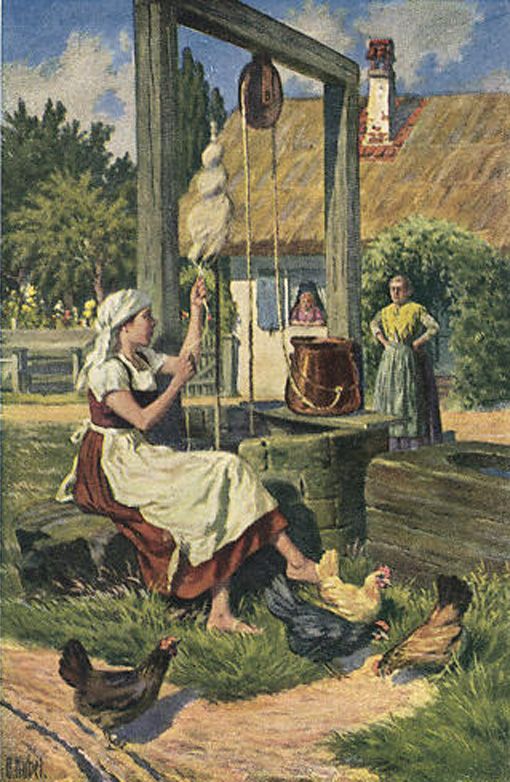 Image: Otto Kubel (1868 – 1951)
Image: Otto Kubel (1868 – 1951)The girl went back to the well not knowing what to do, and at last in her distress she jumped into the water after the spindle. She remembered nothing more until she awoke and found herself in a beautiful meadow, full of sunshine, and with countless flowers blooming in every direction. She walked over the meadow, and presently she came upon a baker’s oven full of bread, and the loaves cried out to her, „Take us out, take us out, or alas! we shall be burnt to a cinder. We were baked through long ago.“ So she took the bread-shovel and drew them all out.
She went on a little farther, till she came to a tree full of apples. „Shake me, shake me, I pray,“ cried the tree; „my apples, one and all, are ripe.“ So she shook the tree, and the apples came falling down upon her like rain; but she continued shaking until there was not a single apple left upon it. Then she carefully gathered the apples together in a heap and walked on again.
The next thing she came to was a little house, and there she saw an old woman looking out, with such large teeth, that she was terrified, and turned to run away. But the old woman called after her, „What are you afraid of, dear child?
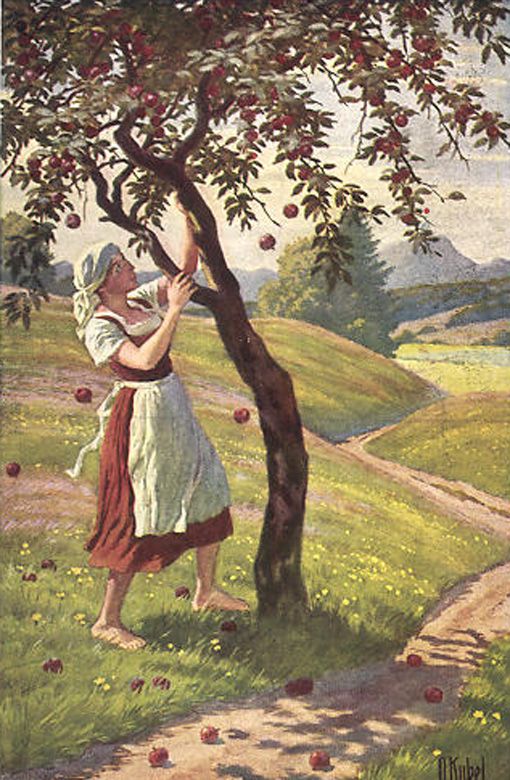 Image: Otto Kubel (1868 – 1951)
Image: Otto Kubel (1868 – 1951)Stay with me. If you will do the work of my house properly for me, I will make you very happy. You must be very careful, however, to make my bed in the right way, for I wish you always to shake it thoroughly, so that the feathers fly about. Then they say, down there in the world, that it is snowing. For I am Mother Holle.“ The old woman spoke so kindly, that the girl summoned up courage and agreed to enter into her service.
She took care to do everything according to the old woman’s bidding, and every time she made the bed she shook it with all her might, so that the feathers flew about like so many snowflakes. The old woman was as good as her word. She never spoke angrily to her, and gave her roast and boiled meats every day.
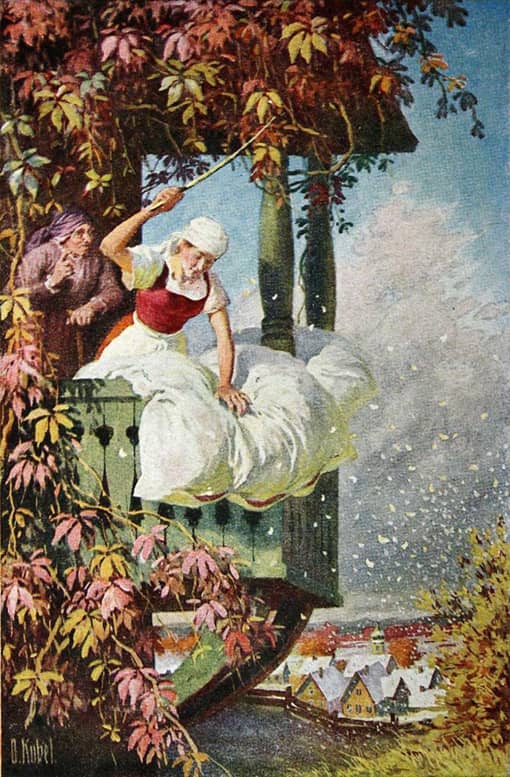 Image: Otto Kubel (1868 – 1951)
Image: Otto Kubel (1868 – 1951)So she stayed on with Mother Holle for some time, and then she began to grow unhappy. She could not at first tell why she felt sad, but she became conscious at last of great longing to go home. Then she knew she was home-sick, although she was a thousand times better off with Mother Holle than with her mother and sister. After waiting awhile, she went to Mother Holle and said, „I am so homesick, that I cannot stay with you any longer, for although I am so happy here, I must return to my own people.“
Then Mother Holle said, „I am pleased that you should want to go back to your own people, and as you have served me so well and faithfully, I will take you home myself.“
Thereupon she led the girl by the hand up to a broad gateway. The gate was opened, and as the girl passed through, a shower of gold fell upon her, and the gold clung all her, so that she was covered with it from head to foot.
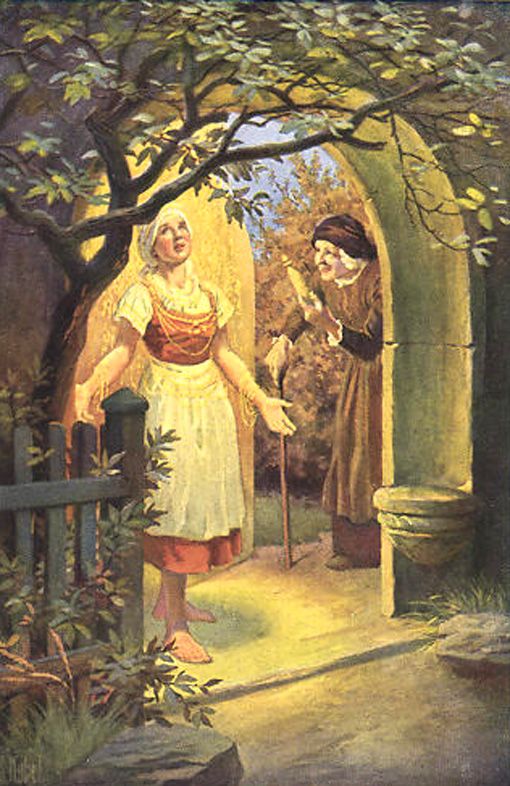 Image: Otto Kubel (1868 – 1951)
Image: Otto Kubel (1868 – 1951)„That is a reward for your industry,“ said Mother Holle, and as she spoke she handed her the spindle which she had dropped into the well.
The gate was then closed, and the girl found herself back in the old world close to her mother’s house. As she entered the courtyard, the cock, who was perched on the well, called out—
„Cock-a-doodle-doo!
Your golden daughter’s come back to you.“
Then she went in to her mother and sister, and as she was so richly covered with gold, they gave her a warm welcome.
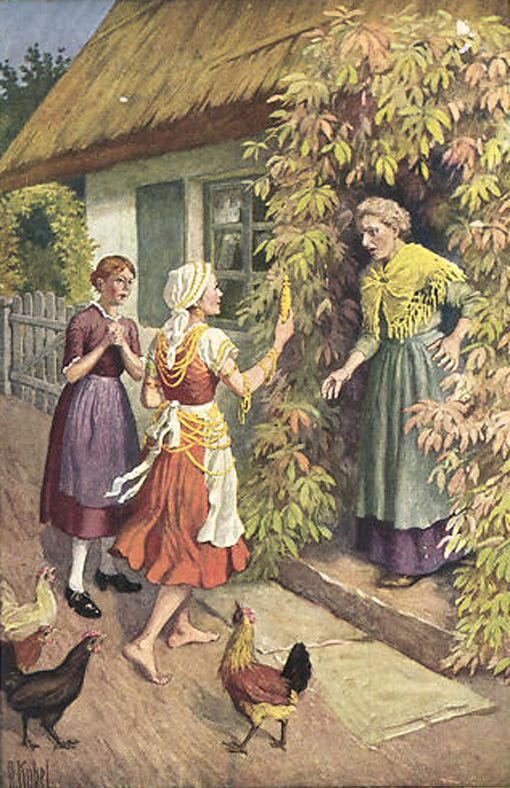 Image: Otto Kubel (1868 – 1951)
Image: Otto Kubel (1868 – 1951)She related to them all that had happened, and when the mother heard how she had come by her great riches, she thought she should like her ugly, lazy daughter to go and try her fortune. So she made the sister go and sit by the well and spin, and the girl pricked her finger and thrust her hand into a thorn-bush, so that she might drop some blood on to the spindle. Then she threw it into the well, and jumped in herself.
Like her sister, she awoke in the beautiful meadow, and walked over it till she came to the oven. „Take us out, take us out, or alas! we shall be burnt to a cinder. We were baked through long ago,“ cried the loaves as before. But the lazy girl answered, „Do you think I am going to dirty my hands for you?“ and walked on.
Presently she came to the apple tree. „Shake me, shake me, I pray; my apples, one and all, are ripe,“ it cried. But she only answered, „A nice thing to ask me to do, one of the apples might fall on my head,“ and passed on.
At last she came to Mother Holle’s house, and as she had heard all about the large teeth from her sister, she was not afraid of them, and engaged herself without delay to the old woman.
The first day she was very obedient and industrious, and exerted herself to please Mother Holle, for she thought of the gold she should get in return. The next day, however, she began to dawdle over her work, and the third day she was more idle still. Then she began to lie in bed in the mornings and refused to get up.
Worse still, she neglected to make the old woman’s bed properly, and forgot to shake it so that the feathers might fly about. So Mother Holle very soon got tired of her, and told her she might go. The lazy girl was delighted at this, and thought to herself, „the gold will soon be mine.“ Mother Holle led her, as she had her sister, to the broad gateway; but as she was passing through, instead of the shower of gold, a great bucketful of pitch came pouring over her.
„That is in return for your services,“ said the old woman, and she shut the gate. So the lazy girl had to go home covered with pitch, and the cock on the well called out as he saw her—
„Cock-a-doodle-doo!
Your dirty daughter’s come back to you.“
But, try what she would, she could not get the pitch off, and it stuck to her as long as she lived.
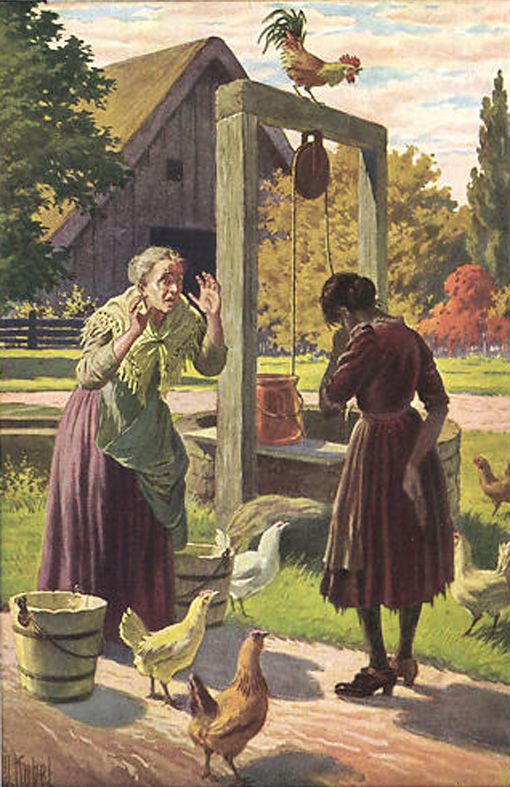 Image: Otto Kubel (1868 – 1951)
Image: Otto Kubel (1868 – 1951) Learn languages. Double-Tap on one word.Learn languages in context with Childstories.org and Deepl.com.
Learn languages. Double-Tap on one word.Learn languages in context with Childstories.org and Deepl.com.Backgrounds to fairy tale „Mother Holle“
„Mother Holle,“ also known as „Frau Holle“ or „Mother Hulda,“ is a German fairy tale collected by the Brothers Grimm in their compilation „Grimm’s Fairy Tales.“ The story has its origins in German folklore and oral storytelling traditions. Mother Holle is believed to be based on an ancient Germanic goddess associated with the household, the hearth, and spinning, though her character has evolved over time.
The story’s themes reflect the values and beliefs of the society in which it originated. It emphasizes the importance of hard work, kindness, and honesty, rewarding those who demonstrate these virtues and punishing those who do not. The tale also highlights the power of women, as the central characters are female, and Mother Holle is a wise, powerful figure.
In addition to the Brothers Grimm’s collection, the story of Mother Holle has been passed down through generations of storytellers in different regions, leading to various versions and adaptations. Some of these adaptations may have altered the story to fit the values and expectations of the audience or the time period in which they were created. Regardless of the variations, the core message of the story remains consistent, demonstrating the lasting appeal and cultural importance of this traditional fairy tale.
The Brothers Grimm, Jacob and Wilhelm, were German academics, linguists, and cultural researchers who sought to preserve traditional folklore and stories. They collected and published numerous folktales in their famous book, „Grimms‘ Fairy Tales“ (originally titled „Children’s and Household Tales“) in 1812. „Mother Holle“ is part of the Aarne-Thompson-Uther (ATU) classification system, which is a comprehensive indexing system for folktales. The story is classified as ATU 480, „The Kind and the Unkind Girls“ or „The Two Travelers.“ This classification encompasses stories in which two contrasting characters undergo similar experiences, but their different behaviors result in opposite outcomes.
The character of Mother Holle (or Frau Holle) is derived from Germanic and pre-Christian mythology. She is often associated with the goddess Hulda or Holda, a figure in German folklore who presides over domestic life, spinning, and the weather. In the fairy tale, Mother Holle’s connection to the weather is evident in her bed-shaking ritual, which results in snowfall in the world below. The story of „Mother Holle“ has been adapted and retold in various forms throughout the years, including plays, films, and illustrated books. Its moral lessons and themes continue to resonate with audiences today, highlighting the importance of hard work, kindness, and personal responsibility.
Interpretations to fairy tale „Mother Holle“
„Mother Holle“ has been interpreted in various ways, with different aspects of the story resonating with audiences over time. Some common interpretations of the fairy tale include:
Moral lessons: The story teaches the importance of hard work, kindness, and honesty. The diligent and kind stepdaughter is rewarded for her efforts, while the lazy and mean stepsister is punished for her behavior. This moral lesson reinforces the idea that good deeds will be rewarded, and bad deeds will be punished.
Female empowerment: Mother Holle is a powerful figure who holds authority over the rewards and punishments given to the two stepdaughters. The story also centers around female characters and their actions, emphasizing the importance of women and their roles in society.
The transformative power of nature: The well in the story serves as a portal to another world, where the stepdaughters encounter Mother Holle. This can be seen as a symbol of the transformative power of nature, allowing the characters to undergo personal growth and change as they face new experiences and challenges.
The significance of spinning and domestic work: The stepdaughter’s willingness to perform the spinning task is central to the story. Spinning was a common domestic task associated with women in traditional societies, and the story highlights the importance of this work in the home.
The dual nature of humanity: The contrasting characters of the kind stepdaughter and the cruel stepsister represent the dual nature of humanity, showing that people can be both good and evil. The story emphasizes the importance of choosing to act with kindness and compassion.
The role of the mother figure: Mother Holle can be seen as a nurturing and wise mother figure who teaches the stepdaughters valuable life lessons. The story suggests that a loving and supportive mother figure is essential for personal growth and development.
The value of hard work and diligence: The industrious step-daughter is rewarded for her hard work and dedication, while the lazy daughter faces punishment for her idleness. The story emphasizes the importance of being diligent, responsible, and committed to one’s duties.
The consequences of one’s actions: Both sisters experience the outcomes of their actions, whether positive or negative. The tale illustrates the idea that actions have consequences, and individuals are accountable for their behavior.
Kindness and compassion: The industrious step-daughter shows kindness and compassion by helping the talking bread and apple tree. In return, she receives kindness from Mother Holle and is rewarded with a shower of gold. The story emphasizes the importance of treating others with kindness and empathy.
Inner qualities over outer appearances: Despite the lazy daughter’s physical beauty, her actions and behavior lead to her downfall. Conversely, the industrious step-daughter’s positive traits are rewarded. The tale teaches that inner qualities, such as hard work, kindness, and integrity, are more important than external appearances.
The power of choice: Both sisters face similar situations but make different choices. The industrious step-daughter chooses to work hard and be kind, while the lazy daughter decides to be disrespectful and idle. The story highlights the power of choice and the impact personal decisions can have on one’s life.
Overall, „Mother Holle“ offers a rich tapestry of themes and interpretations, which have contributed to its enduring popularity as a classic fairy tale.
Adaptions of the fairy tale „Mother Holle“
„Mother Holle“ has been adapted in various forms over the years, including books, films, television shows, and theater productions. Some examples of these adaptations include:
Picture books and illustrated editions: Illustrated versions of the fairy tale have been published for children, with various artists contributing their own unique visual interpretations of the story.
Animated films and television shows: Animated adaptations of „Mother Holle“ have appeared in various formats, such as the 1954 East German film „Frau Holle“ directed by Gottfried Kolditz and the 1963 West German film „Frau Holle“ directed by Peter Podehl. The story has also been adapted as an episode in the popular Russian animated series „Skazka Skazok“ (Tale of Tales). „Mother Hulda“ (1985): This West German film directed by Vera Loebner is a loose adaptation of „Mother Holle.“ The film follows a young girl named Lina who falls into a well and enters a magical realm ruled by Mother Hulda. Like Goldilocks, Lina is rewarded for her hard work and honesty, but her stepsister tries to steal the reward and is punished for her laziness. „Frau Holle“ (2008): This German film directed by Thomas Freundner is a modern retelling of „Mother Holle.“ The film follows two sisters, Marie and Sophie, who fall into a well and enter a magical realm ruled by Frau Holle. The film emphasizes the importance of sisterhood and loyalty, as well as the consequences of greed and selfishness. „Mother Holly“ (2012): This animated short film directed by Mikhail Aldashin is a minimalist adaptation of „Mother Holle.“ The film features a simple, hand-drawn animation style and emphasizes the magical and dreamlike aspects of the story. „Mother Hulda“ (2018): This German television film directed by Thomas Freundner is a modern adaptation of „Mother Holle.“ The film follows a young girl named Luisa who falls into a well and enters a magical realm ruled by Mother Hulda. Like other adaptations, the film emphasizes the importance of hard work and honesty, as well as the dangers of greed and deceit.
Live-action films and television shows: „Mother Holle“ has been adapted as live-action films and television episodes, such as the 1985 East German film „Frau Holle“ directed by Wolfgang Hübner and the 2008 German TV movie „Frau Holle“ directed by Bodo Fürneisen. The story has also been featured in episodes of popular fairy tale anthology TV series like „Grimm’s Fairy Tale Classics“ and „Jim Henson’s The Storyteller.“
Theater productions: „Mother Holle“ has been adapted for the stage as part of children’s theater productions and puppet shows, often focusing on the moral lessons and fantastical elements of the story.
Operas and musicals: The fairy tale has inspired operas and musical adaptations, such as the opera „Frau Holle“ composed by Othmar Schoeck in 1939 and the musical „Frau Holle“ by Wolfgang Adenberg and Paul Glaser in 2010.
Modern retellings and reinterpretations: Authors have reimagined „Mother Holle“ in contemporary settings or with new twists on the original tale. For example, author Tanith Lee retells the story with a darker tone in her short story „Uous“ from the collection „Red as Blood, or Tales from the Sisters Grimmer.“
These adaptations demonstrate the enduring appeal of „Mother Holle“ and its ability to captivate audiences across various formats and cultures. These are just a few examples of how „Mother Holle“ has inspired adaptations in different forms of media. The story’s enduring appeal and universal themes continue to inspire new interpretations and adaptations.
Summary of the plot
„Mother Holle“ is a fairy tale by the Brothers Grimm that tells the story of two stepsisters with contrasting personalities. One sister is kind and diligent, while the other is lazy and mean-spirited. Their widowed mother favors the lazy daughter and treats the diligent one poorly, making her do all the housework.
One day, while the diligent girl is spinning near a well, she accidentally drops her spindle into the water. Afraid of her stepmother’s anger, she jumps into the well to retrieve it. Instead of drowning, she finds herself in a beautiful meadow in another world. As she explores this new place, she meets an old woman who turns out to be Mother Holle, a kind and magical figure who rewards hard work.
Mother Holle asks the girl to help with household tasks, and the girl agrees, performing her duties diligently. After some time, the girl becomes homesick and wishes to return. Mother Holle, pleased with the girl’s hard work, leads her to a gate and showers her with gold as she passes through, sending her back to her own world. The girl also finds her lost spindle near the well.
Seeing her stepsister covered in gold, the lazy daughter decides to jump into the well, hoping for the same reward. Once in the magical world, she encounters Mother Holle but is unwilling to help with any tasks. Mother Holle eventually sends her back through the gate, but instead of gold, the girl is showered with pitch, which sticks to her for the rest of her life. The story of „Mother Holle“ teaches the importance of hard work and kindness, showing that these qualities will be rewarded while laziness and selfishness will lead to misfortune.
The plot of the fairy tale
„Mother Holle“ is a Brothers Grimm fairy tale about a widow who has two daughters: one beautiful and industrious, and the other ugly and lazy. The widow favors her lazy daughter, and the industrious step-daughter is mistreated, forced to do all the housework. One day, while spinning by a well, the girl’s spindle falls in, and she dives in after it. She awakens in a beautiful meadow, where she encounters talking bread in an oven and a tree full of ripe apples. She helps both, and then comes across Mother Holle’s house. Despite being scared of the old woman’s large teeth, she agrees to work for her.
The girl works diligently, shaking the old woman’s bed so the feathers fly about like snowflakes. Mother Holle treats her well, and eventually, the girl becomes homesick. Mother Holle rewards her with a shower of gold and returns her to her family.
Seeing her sister’s fortune, the lazy daughter decides to try the same. However, she is rude to the talking bread and apple tree, and disobeys Mother Holle by being lazy and neglectful. As a result, she is covered in pitch instead of gold when she returns home, and the pitch sticks to her for the rest of her life, illustrating the consequences of one’s actions and the importance of hard work and kindness.
Informations for scientific analysis
Fairy tale statistics | Value |
|---|---|
| Number | KHM 24 |
| Aarne-Thompson-Uther-Index | ATU Typ 480 |
| Translations | DE, EN, EL, DA, ES, FR, PT, FI, HU, IT, JA, NL, PL, RO, RU, TR, VI, ZH |
| Readability Index by Björnsson | 29.4 |
| Flesch-Reading-Ease Index | 80.6 |
| Flesch–Kincaid Grade-Level | 6.9 |
| Gunning Fog Index | 9.4 |
| Coleman–Liau Index | 7.2 |
| SMOG Index | 8.2 |
| Automated Readability Index | 6.8 |
| Character Count | 6.599 |
| Letter Count | 4.995 |
| Sentence Count | 65 |
| Word Count | 1.278 |
| Average Words per Sentence | 19,66 |
| Words with more than 6 letters | 124 |
| Percentage of long words | 9.7% |
| Number of Syllables | 1.606 |
| Average Syllables per Word | 1,26 |
| Words with three Syllables | 49 |
| Percentage Words with three Syllables | 3.8% |

















